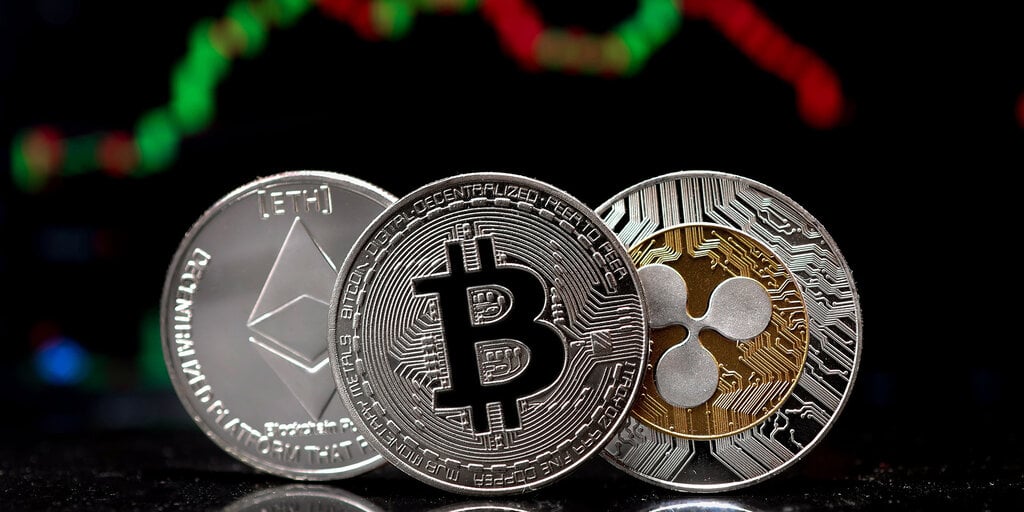Crypto Prices Extend Losses Amid Escalating Trade Tensions and Inflation Concerns
Market Volatility
Crypto prices have extended their losses, trading lower alongside U.S. stock futures as investors react to escalating trade tensions and renewed inflation concerns ahead of a busy week for financial markets.
Crypto Market Performance
Bitcoin has slipped to $82,100, while Ethereum has dipped to approximately $1,790. XRP, meanwhile, has fallen to $2.13, according to CoinGecko data.
Market Analysis
The drop follows weeks of volatility in equities, with major tech stocks retreating sharply and broader sentiment weakening. Futures tied to the S&P 500 and Nasdaq-100 dropped roughly 0.7% to 0.8%, while Dow futures lost 0.55% in early trading.
Trade Tensions and Tariffs
The declines come ahead of the April 2 rollout of reciprocal tariffs announced by President Donald Trump, which Barclays says could affect as many as 25 countries. Sectors likely to be most affected include automobiles, pharmaceuticals, and semiconductors.
Tax Revenue Service
The tariff package is part of a broader effort by the Trump administration to generate $600 billion in annual revenue through a new collection mechanism referred to as the "External Revenue Service." Auto-related tariffs alone are expected to impact more than $275 billion in imports annually.
Consumer Sentiment
As a result, U.S. consumer sentiment has deteriorated sharply. The Kobeissi Letter, a financial publication, reported Sunday that sentiment has fallen by roughly 20 points in the past month to a reading of 57, the lowest level recorded outside of a formal recession. "An economic slowdown has clearly begun," the report said.
Inflation Pressures
Analysts expect inflation pressures to accelerate across most sectors of the U.S. economy. Data from the prior Trump-era trade conflict showed a 4% rise in PCE prices among tariff-affected categories, while prices in non-affected sectors declined 2%, according to The Kobeissi Letter.
Crypto Market Reaction
The pullback in crypto reflects broader caution among investors, particularly as large institutional capital continues to rotate out of risk-heavy positions. Meanwhile, the so-called "Magnificent 7" stocks have lost more than $3 trillion in market capitalization in recent weeks. Retail participation remains active, but volatility has increased across both traditional and digital markets.
Inflation Hedges
While some investors view Bitcoin as a potential inflation hedge, short-term correlations with equities suggest crypto remains tied to broader macroeconomic sentiment.
Conclusion
In conclusion, the crypto market is experiencing a period of heightened volatility, with prices extending their losses amid escalating trade tensions and renewed inflation concerns. As investors react to the unfolding situation, it is essential to remain informed and adapt to the changing market dynamics.
FAQs
Q: What are the potential implications of the Trump administration’s trade tariff plan on the global economy?
A: The plan could have significant implications for global trade, including the potential for retaliatory measures and increased trade tensions.
Q: How is the crypto market reacting to the current market volatility?
A: The crypto market is experiencing a period of heightened volatility, with prices extending their losses amid escalating trade tensions and renewed inflation concerns.
Q: What is the current state of consumer sentiment in the United States?
A: Consumer sentiment has deteriorated sharply, with a recent report indicating a 20-point decline in sentiment over the past month, reaching its lowest level recorded outside of a formal recession.
Q: How are institutional investors reacting to the current market dynamics?
A: Institutional investors are rotating out of risk-heavy positions, leading to increased caution in the market.
Q: What are the potential implications of the current market conditions on the global economy?
A: The current market conditions could have significant implications for the global economy, including the potential for increased volatility and decreased investor confidence.









